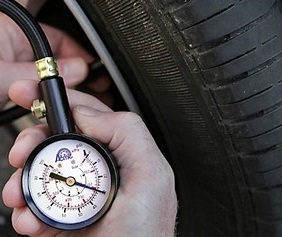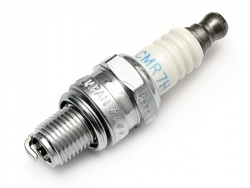Your car’s fuel efficiency is dependent on several factors such as your driving style. It is common knowledge that abrupt accelerations and unnecessary braking can lead to high wastage. But there are a few other hidden vampires that can quietly suck up the petrol in your car.
So if you are interested in slaying these baddies, read on.
Fuel inefficiency is rarely the result of any single issue. Almost always, the problem stays on even after you have fixed one of those problems. Thus you have to get your car properly diagnosed by a qualified mechanic.
Under Inflated Tires & Other Tire Issues
 One of the most common drags your engine has to fight against is under-inflated tires. Fortunately this is very easy to fix. Nevertheless this is also most overlooked.
One of the most common drags your engine has to fight against is under-inflated tires. Fortunately this is very easy to fix. Nevertheless this is also most overlooked.
Under-inflated tires lower your mileage by 0.3 percent for each psi drop in pressure (in all four tires). This may not seem significant. Yet if you ignore this, the cost will not be limited to just a drop in fuel efficiency. You will end up with a set of prematurely bald tires too.
Each week, you should (actually you must) check your tire pressure and inflate it to the recommended pressure. This is usually found on a sticker at the driver’s door pillar.
Other than under-inflated tires, improper wheel alignment can also contribute to fuel inefficiency. So get your mechanic to check these each time you are at his workshop.
Engine Oil Issues
The engine oil lubricates the moving parts inside the engine. Over time, the oil thickens. As a result, drag increases and so does fuel efficiency. And if the oil filter gets clogged up, oil flow gets restricted and the engine has to push harder.
Using the correct quality and type of engine oil can save you lots of repair costs in the future. For example, using 10W-30 engine oil on an engine that suits 5W-30 oil can increase the oil consumption by up to 2%.
Broken Oxygen Sensor
An oxygen sensor is part of the emissions control system and feeds data to the engine management computer. This component is responsible for determining how much fuel is injected into the engine. Many cars have an air-fuel ratio sensor installed instead of an oxygen sensor. Although it works differently, its functionality is the same as an oxygen sensor.
Your car burns fuel most efficiently only when a particular ratio of air and gasoline is present. The magic number is 14.7:1. Different fuels have different ratios though. And if this magic number is not present, your engine will not be able to maximise the energy from the fuel. Thus fuel efficiency drops.
Using an oxygen sensor scan tool, your mechanic can quickly determine if this component is still in good working condition. If it is not, it doesn’t take much to switch it out either.
Fuel Injectors – Leaking, Clogged, Worn?
Fuel injectors transport the air-fuel mixture into the engine so combustion can occur. This is a component that wears out over time. Once this happens, spray pattern changes. This results in decreased fuel efficiency too. Even leaky fuel injectors can result in high fuel consumption. Thus you have to clean your fuel injectors regularly or get them changed. Fortunately fuel injectors rarely break and even if they do, it wouldn’t take long to change into new ones.
Spark Plugs
 Have you ever noticed your car becomes a little more powerful whenever you change your spark plugs? This component is responsible for igniting the air/fuel mixture in the engine combustion chambers. Carbon deposits on spark plugs increase resistance. The result is incomplete combustion – and fuel efficiency nosedives. In Singapore, many car owners do not clean spark plugs because it is just too troublesome. But if you are interested, read up on how to do this. After all, spark plugs are relatively inexpensive and you can throw the old ones away if you make a blunder.
Have you ever noticed your car becomes a little more powerful whenever you change your spark plugs? This component is responsible for igniting the air/fuel mixture in the engine combustion chambers. Carbon deposits on spark plugs increase resistance. The result is incomplete combustion – and fuel efficiency nosedives. In Singapore, many car owners do not clean spark plugs because it is just too troublesome. But if you are interested, read up on how to do this. After all, spark plugs are relatively inexpensive and you can throw the old ones away if you make a blunder.
Clogged Catalytic Converter
Catalytic converters are seldom clogged. But if they do, your mileage will spiral rapidly. If your car does not respond adequately as you step on the gas pedal, you may have issues with the catalytic converter. However many other issues can cause this symptom too. Therefore you have to perform a proper diagnostic, which includes measuring the exhaust back-pressure.
Hopefully when catalytic converter issues occur, it is still covered by warranty. Otherwise this can be an expensive component to replace.
Worn Timing Belts
A timing belt (or chain) orchestrates the movement of the camshafts and valves. If the timing belt gets stretched or worn, improper ignition can occur (read: bad fuel efficiency). A trained mechanic can help rectify a problematic timing belt or chain easily. Nevertheless if you change it every 90,000 to 170,000 km, you should not face any issues.
Faulty Thermostat
A thermostat is an important feedback mechanism that enables your engine to run at its optimum temperature. It is a part of the engine cooling system too. With a thermostat, your car can warm up faster and maintain normal operating temperature throughout.
A faulty thermostat upsets this balance. In the end, your vehicle needs more fuel than necessary. Although thermostats are not incredibly expensive, they will usually be difficult to find. Fortunately this is a problem that few car owners will face.
If you get the above points covered, you will almost always attain good fuel efficiency for your car.
Are there any other tips you swear by to get the most mileage out of your vehicle? Share them here with us…
